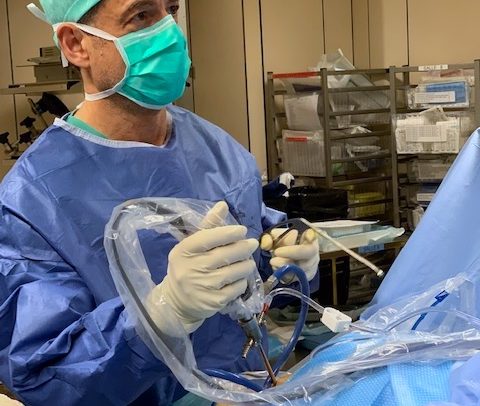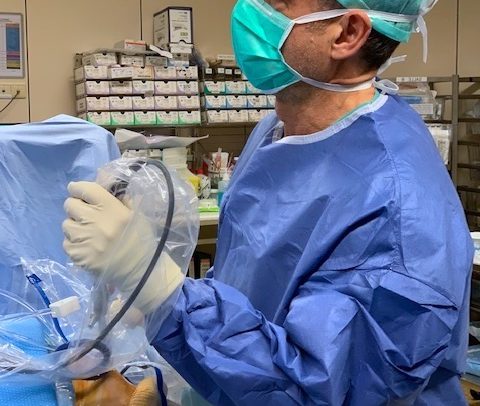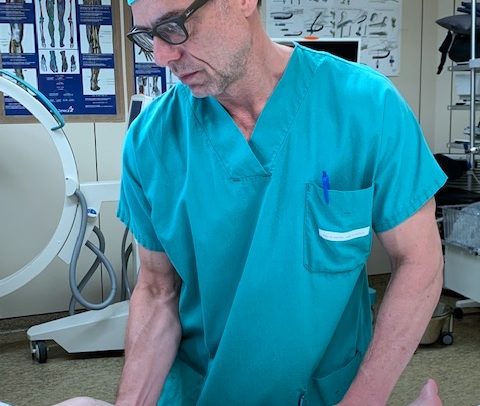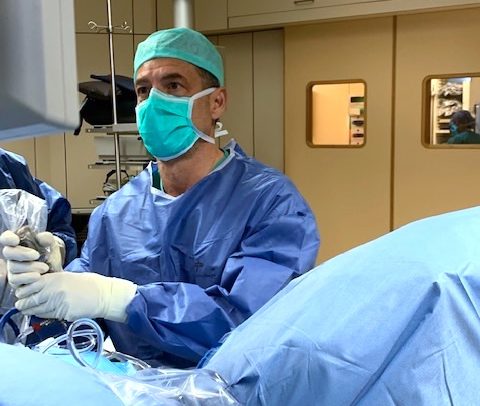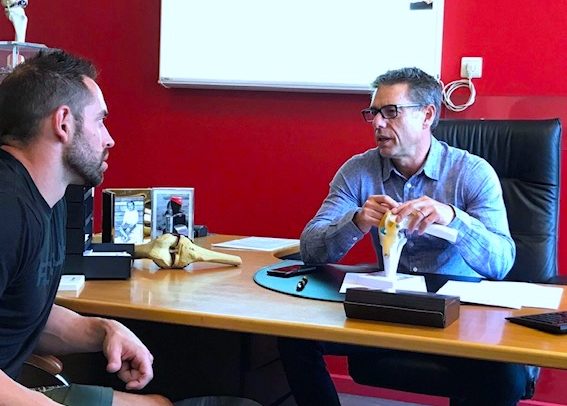For any appointment that requires rapid notice, namely: sports accident or post-operative problems, please contact Ms. Russello at +32 477 851 360 from 9 a.m. to 5 p.m.
KNEE
Surgical procedures for knee pathologies.
HIP
Surgical procedures for hip pathologies.
SHOULDER
Surgical procedures for shoulder pathologies.
I DR. ALAIN KRYKSZTEIN
KNEE, HIP & SHOULDER SPECIALISTE
Doctor Alain KRYKSZTEIN studied medicine at UCL and graduated in 1988.
He received his certification as specialist in orthopaedic and trauma surgery in 1994.
He studied under Professor LEWALLE and Professor VINCENT, two of the most distinguished Belgium orthopaedists.
He started his surgical practice at the CHR de la Haute Senne as part of a multidisciplinary team where he focused on young surgeons’ training.
He subsequently took over the orthopaedicsand sports surgery department management at the Clinique Antoine Depage, where he coordinated the department activities for over 20 years.
He is now in private practice at the Iris-Sud and Chirec hospitals. He is the kneespecialist of reference at the CHU Saint-Pierre where he shares his knowledge with the future orthopaedists.
Doctor Alain KRYKSZTEIN speaks French and English fluently and has a basic knowledge of Dutch and Hebrew.
Docteur Alain KRYKSZTEIN – Orthopaedic Surgeon
Do you want to discuss you knee, hip or shoulder problems?
Contact us today and make an appointment!
I THE KNEE
KNEE, HIP & SHOULDER SPECIALIST
Knee surgery has improved significantly with the emergence of arthroscopic techniques.
New material developments allow for ligament repair and ad integrum restoration of the post-trauma knee operation.
Hospitalisation for this type of surgery is getting shorter and shorter and may even be of a few hours only in come surgery cases.
Wear in the knee joint leads to the fitting of a complete prothesis made of a femoral part, a tibial part and an intermediate piece in-between.
The total knee replacement is certainly the most common arthroplasty after total hip replacement.
These MIS (Minimal Invasive Surgery) surgeries allow for an earlier rehabilitation, a shorter downtime and a significantly reduced cost.
Knee Surgery :
Knee arthroscopic surgery: Post-trauma replacement of the anterior cruciate ligament, meniscectomy, osteochondritis lesions through cartilage graft, knee infection treatment, etc.
Total knee replacement: this surgery enables heavily disabled patients unable to move about to recover their autonomy and walk limited distances. They also regain the physical activity they had lost. Their blood pressure, diabetes and weight are back to normal and their life expectancy is increased compared to the sedentary lifestyle they were subjected to when suffering from gonarthrosis.
Replacement of a worn existing prosthetic
Osteotomy: corrects axis problems leading to an increase in loads on one of the 2 compartments and early knee wear.
Trauma: treatment of femur distal end, tibia proximal end or patella fractures through the fitting of synthetic materials.
Patellar instability: treatment of patellofemoral pain.
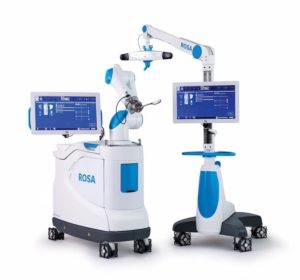 New Robotic Assistance in Knee Prosthetic Surgery
New Robotic Assistance in Knee Prosthetic Surgery
To enhance the quality of care for patients suffering from osteoarthritis, the orthopedic department has acquired a state-of-the-art surgical assistance robot: ROSA.
Using sensors, ROSA models, calculates, and analyzes the patient’s bone anatomy. This 3D reproduction of the joint allows the surgeon to plan the surgical intervention with millimeter precision, respecting the patient’s specific morphology and the balance of their knee. On the day of the operation, ROSA provides the surgeon with precise, real-time information through its navigation and recognition technology. Its articulated arm assists the expert in cutting the bone and custom-fitting the prosthesis.
Personalized Surgeries
This robot has the advantage of enabling highly personalized surgeries, as 15% of patients complain after a more standard operation. “The idea of robotics is to try to achieve a knee that is as close as possible to what it was before the surgical intervention.”
How does ROSA Knee work?
The ROSA Knee system first uses a series of X-rays to create a 3D model of your knee. Depending on your surgical needs, your surgeon will advise you on a clinically proven knee implant system that best suits you. The surgeon will use their experience along with the information from the ROSA Knee system to plan the specific details of your knee arthroplasty before your surgery.
During surgery, the ROSA Knee system uses a camera and a sensor to know exactly where your knee is, and it can detect even the smallest movements in real-time. By providing live feedback throughout the surgery via a digital display and using a robotic guidance arm, the ROSA Knee system helps your surgeon to precisely place the implant according to the plan.
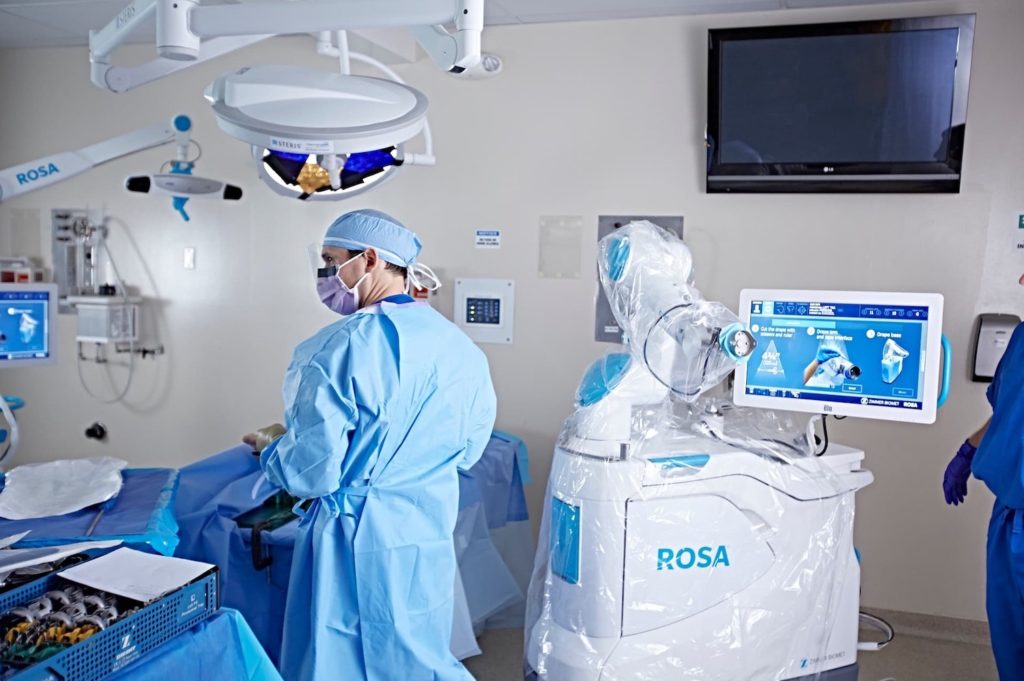
Finally, to ensure the best possible outcome, the ROSA Knee system helps the surgeon evaluate the knee with the implant in place. This allows your surgeon to make the final precise adjustments before completing the surgery. For this reason, it has been shown that robot-assisted surgery improves overall outcomes and is associated with lower postoperative revision rates.
The ROSA Knee system combines precise data and a robotic arm with the skills and experience of your surgeon to deliver surgery that results in a more accurately placed implant position than that achieved by traditional methods. However, the robot does not perform the operation; it assists the surgeons with live data and guidance throughout the procedure, moving only when directed by the surgeon.
I THE HIP
KNEE, HIP & SHOULDER SPECIALIST
The most common hip pathology today is coxarthrosis (hip arthrosis).
This pathology is caused by our lifestyle and the increase in population ageing.
Inflammatory pathologies are also very common and often lead to a destruction of the hip joint.
We also see many cases of trauma-related ligament pathologies as well as after-effects of surgeryor replacement of worn-out prosthetic.
The relief of Hip pain is achieved through a thorough clinical examination and suitable imaging.
Treatments are of course mainly conservative and resorting to surgery should all other orthopaedic treatments have failed will enable the patient to recover his autonomy and resume suitable exercise.
Hip Surgery :
Total hip replacement: replacement of the joint with a femoral part, a cotyloidal part and an intermediate part to allow these three prosthetics to slide without friction.
Work on total hip prosthetics: if the friction torque is worn out or in case of wrong positioning or loosening the entire prosthetics will have to be replaced.
Hip osteotomy: now extremely rare, osteotomy corrects congenital disorders.
Surgery on soft parts (tendons, ligaments): these are often trauma pathologies caused by excess exercise or sport trauma.
Hip arthroscopy: allows treatment on the hip socket and impingements.
Fracture, osteonecrosis, inflammatory pathologies: these pathologies often lead to the fitting of a complete hip prosthetics to recover autonomy.
I THE SHOULDER
KNEE, HIP & SHOULDER SPECIALIST
Shoulder surgery improved significantly over the past few years with the introduction of arthroscopy andminimal invasive techniques.
These techniques allow for the repair of sport and degenerative lesions such as cuff tear, instability or impingements.
The duration of hospital stays has been reduced to the minimum thanks to spinal block anaesthesia that allows the patient to go home painlessand with minimal discomfort.
Shoulder Surgery :
Rupture of rotator cuffs: arthroscopy or minimal invasion surgery opens the door to cuff lesions through suture and enables the patient to recover normal function, strength and mobility almost as good as before surgery.
Instability: arthroscopy allows for repairs to the coracoid process. It is possible to reinsert this coracoid process with physiotherapy and enable the patient to resume his sport activities without any risk of recurring dislocation on this joint.
Subacromial impingement: subacromial decompression through arthroscopy is a very common procedure that allows the patient to recover shoulder mobility and avoid cuff rupture caused by this impingement.
Total shoulder replacement: this procedure is the replacement of the shoulder joint with a prosthetics. It is done in case of omarthrosis (shoulder arthrosis). The patient recovers mobility and the pain is eliminated.
There are solutions available for your pain and discomfort.
Arthroscopy, ligamentoplasty, meniscectomy, sport surgery, arthrosis, orthopaedist, gonarthrosis, coxarthrosis, omarthrosis, knee replacement, hip replacement, shoulder replacement, rotator cuff rupture, rotator cuff suture, acromioplasty, subacromial impingement.
I CONTACT
KNEE, HIP & SHOULDER SPECIALIST
Barbara RUSSELLO has been working as Doctor KRYKSZTEIN’s secretary for many years. She is known for her kindness and professionalism. She is the interface between the patient and Doctor KRYKSZTEIN.
Please note that email is exclusively for administrative issues. Doctor KRYKSZTEIN does not consult via email.
I CONSULTATIONS
KNEE, HIP & SHOULDER SPECIALIST
Cabinet Médical Privé
(Av. Louise)
Dr Kryksztein
Orthopédiste
TELEPHONE
02 267 37 65
0477 851 360 (Barbara Russello)
ADDRESS
363 Avenue Louise
1050 IXELLES
SCHEDULE
Opening: October 2019
PARKING
Nearby streets
Public transportation
Tram 8 / Tram 93
Stop: Abbaye
Centre Médical
Edith Cavell
TELEPHONE
02 434 81 01
ADDRESS
37 Rue Général Lotz
1180 UCCLE
SCHEDULE
Opening Soon
PARKING
Parking located at the intersection of rue Général Lotz and rue Vanderkindere
Public transportation
Bus 60
Stop:
Tram 7
Stop:
Tram 3
Stop: Winston Churchill




